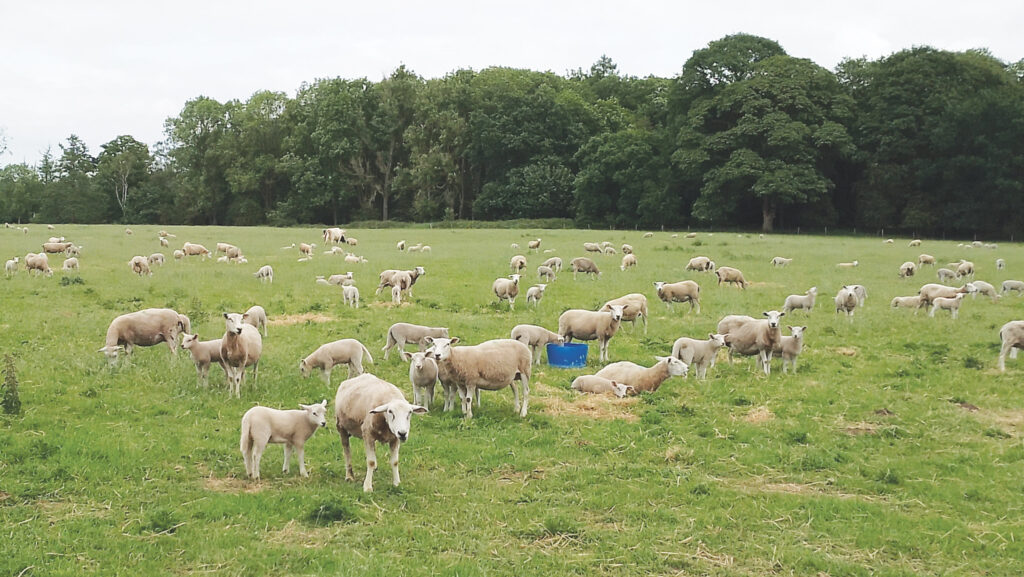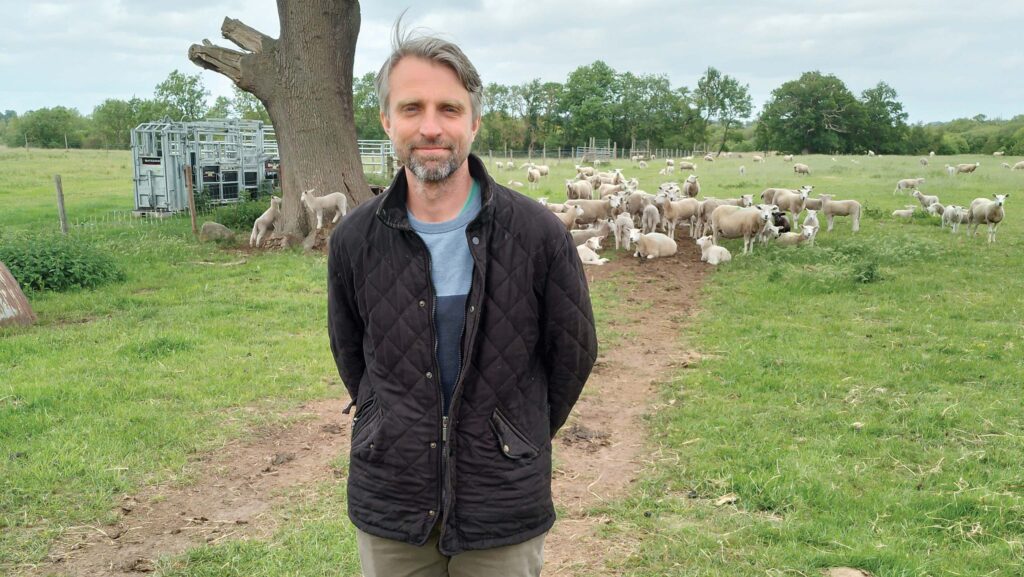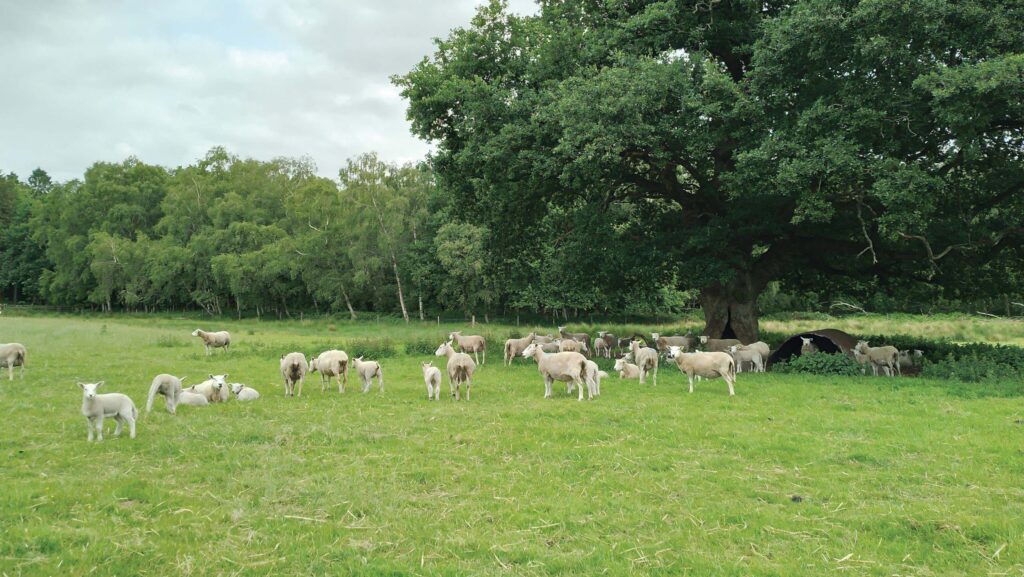How a robust hybrid ewe flock is thriving on regen system
 © Helen Brothwell
© Helen Brothwell Transitioning to regenerative grazing on the family farm at Aqualate Estate on the Shropshire/Staffordshire border and switching to home-bred rams has helped improve flock health for Wojtek Behnke.
He has also saved on labour and maintained similar financial margins.
When Wojtek returned home to farm in 2015, there were 300 mainly Lleyn ewes, lambed indoors.
See also: How regen practices can help cut inputs for livestock farmers
Today, ewe numbers are down to 200, on a regenerative grazing system alongside 120 Northern Dairy Shorthorn cows – a dual-purpose breed run as a beef suckler herd on a share-farming agreement with a neighbour.
Some beef and lamb is sold directly via meat boxes, and the estate also runs an arable enterprise alongside a golf course and rented cottages, and it is home to Aqualate Mere, a wetland site of special scientific interest.
Farm facts
Aqualate Estate, Shropshire/Staffordshire border
- 200 Lleyn-cross ewes
- 120 Northern Dairy Shorthorn beef suckler cows
- 100ha grazing platform
- 150% average scanning rate
- 8% lamb mortality
Sheep and cattle are important to manage the grassland and balance the farm’s ecosystem, providing muck as low-cost fertiliser and organic matter for arable crops.
“I’m not looking to produce the biggest, fattest lambs in the market.
“My goal is to produce a quality piece of meat, reared sustainably with minimal intervention and high in nutritional density,” explains Wojtek.

Wojtek Behnke © Helen Brothwell
The focus is on improving genetics and breeding animals that are well-adapted to their environment and perform best on their specific farm, he says.
This is inspired by the estate’s red and fallow deer herds, which have naturally evolved to thrive without inputs.
Home-bred rams
Ewes were originally Lleyn bred with Lleyn, Texel or Mule-type tups.
They have been on the farm for 25 years and are now a hybrid of these breeds.
“They know these fields and have adapted to the mix of species growing here, so I decided not to bring in a new or rare breed,” adds Wojtek.
Previously, he says they would buy in new rams every few years, but now all ram lambs are left entire and kept in a group at weaning.
Single rams are sold as finished lambs as soon as they are ready to go and the best twin rams are kept for breeding.
“The twin has already proved it has the genetics to survive along with another lamb in our particular system.”
Rams go in with the ewes for tupping for four weeks from 20 November to ensure a three-week lambing window.
“There can be anywhere between 15 and 40 rams.
“We sell them all after tupping, which makes sure that a daughter and a sire don’t breed in future.
“There is still a risk of a son breeding with a dam, but the likelihood of this is relatively low with a new set of rams each year.”
Grazing management
Sheep and cattle share the same grazing platform of about 100ha (250 acres), with cattle following the sheep.
Typically, stock move every three days, but it can be anything between one and four days, based on grass growth and stock appetite.
Initially, fencing and splitting up fields enabled rest periods of three months, but now the rest period is around four to six weeks.
“We could probably get better growth rates and longer rest periods for the grass if we were still splitting up fields, but our layout makes it easy to manage as it is.
“It’s not going to be the solution for everyone,” explains Wojtek.
All stock outwinter. Hay and silage are made from herbal leys grown on former arable land, with bales rolled out in the field in winter to supplement grazed grass.

© Helen Brothwell
The herbal leys have been left to see which species grow best and similarly for the grassland, Wojtek does not reseed too often, preferring to see what the land is best suited to growing and whether stock are doing well on it.
Flock health
Ewes are vaccinated with Heptavac as a precaution and sheep are not routinely wormed.
Because cattle are grazing the same platform, they remove sheep parasites and vice versa, helping to keep worm burden down. Grazing ewes on taller covers also helps.
Ewes are now sheared in March – one month before lambing – to avoid the stress of lambs being away from the ewes and to help reduce the risk of fly strike early in the season.
“We shear with a cover comb to leave a bit more wool on and leave them in the shed for a few weeks before they go back out to pasture for lambing.”
Worming, fly treatment and antibiotics are given only when there is a problem and treated individuals are then removed from the breeding programme.
Wojtek says he does not want to “intervene or provide inputs that act as crutches” otherwise he cannot identify those sheep that do not work well in his system.
Lambing system
Outdoor lambing started four years ago, from around 20 April. There is no tail docking, castration or navel dipping.
Ewe lambs are left in the same field as older ewes so they can learn, and a drone is used to assist with lambing checks.
The first season was a learning process, says Wojtek, with the ewes unfamiliar with outdoor lambing and there was some mismothering.
Losses reached 20%, before falling to 15%, then to 8% for the past two years, usually only occurring two to three days post-lambing.
Ewes with singles are now kept together in one field, while ewes with twins are moved into another field.
In the previous system, lambing mortality indoors was about 10-12%, with higher post-lambing mortalities, greater disease issues and a lot of lambs lost from nematodirus after a month old.
How drone assists lambing
A drone is used to help check and monitor ewes during lambing at Aqualate Estate.
Ewes are familiar with the drone, so it does not disturb them and it saves labour, taking only about 15 minutes to manually fly it and check all the sheep.
It also avoids soil compaction from driving over the fields, says Wojtek Behnke.
When they first started lambing outdoors, Wojtek says they used the drone to check sheep four times a day.
As their confidence in the drone grew, this dropped to just once or twice a day and now it’s only needed occasionally for peace of mind.
He is interested in working with drone companies to develop the technology for autonomous drone livestock monitoring.
“A drone could be programmed to identify how many units of livestock there are and which have moved or not, and might need attention.
“It would continue to be an assistant, not a complete replacement for the stockperson.”
Performance and margins
Scanning percentage averages 150%, compared with about 200% in the previous indoor lambing system.
The total net margin earned from the 200 sheep is around £15,000/year (before staff wages), with an income of £20,000-£25,000 and costs of circa £5,000 (excluding Wojtek’s labour).
There is one other full-time employee on the farm, spread across livestock and arable work.
The margin was very similar from 300 sheep before the move to the new system, yet the higher income was offset by greater costs and considerably more time input.
